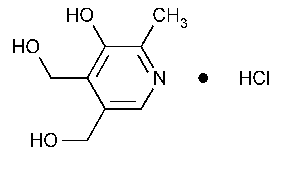Pyridoxine Hydrochloride
3,4-Pyridinedimethanol,5-hydroxy-6-methyl-,hydrochloride.
Pyridoxol hydrochloride [58-56-0].
»Pyridoxine Hydrochloride contains not less than 98.0percent and not more than 102.0percent of C8H11NO3·HCl,calculated on the dried basis.
Packaging and storage—
Preserve in tight,light-resistant containers.
Identification—
A:
Infrared Absorption á197Mñ.
B:
It responds to the tests for Chloride á191ñ.
Loss on drying á731ñ—
Dry it in vacuum over silica gel for 4hours:it loses not more than 0.5%of its weight.
Residue on ignition á281ñ:
not more than 0.1%.
Heavy metals,Method IIá231ñ:
0.003%.
Organic volatile impurities,Method Iá467ñ:
meets the requirements.
Chloride content—
Dissolve about 500mg,accurately weighed,in 50mLof methanol in a glass-stoppered flask.Add 5mLof glacial acetic acid and 2to 3drops of eosin Y TS,and titrate with 0.1Nsilver nitrate VS.Each mLof 0.1Nsilver nitrate is equivalent to 3.545mg of Cl.Not less than 16.9%and not more than 17.6%of Cl,calculated on the dried basis,is found.
Assay—
Mobile phase—
Mix 20mLof glacial acetic acid,1.2g of sodium 1-hexanesulfonate,and about 1400mLof water in a 2000-mLvolumetric flask.Adjust with glacial acetic acid or 1Nsodium hydroxide to a pHof 3.0.Add 470mLof methanol,dilute with water to volume,mix,and filter through a 0.5-µm filter.Make adjustments if necessary (see System Suitabilityunder Chromatography á621ñ).
Internal standard solution—
Dissolve p-hydroxybenzoic acid in Mobile phaseto obtain a solution having a concentration of 5mg per mL.
Standard preparation—
Dissolve about 50mg of USP Pyridoxine Hydrochloride RS,accurately weighed,in Mobile phasein a 100-mLvolumetric flask,dilute with Mobile phaseto volume,and mix.Transfer 10.0mLof the resulting solution to a 100-mLvolumetric flask,add 1.0mLof Internal standard solution,dilute with Mobile phaseto volume,and mix to obtain a solution having a known concentration of about 0.05mg per mL.
Assay preparation—
Dissolve about 50mg of Pyridoxine Hydrochloride,accurately weighed,in Mobile phasein a 100-mLvolumetric flask,dilute with Mobile phaseto volume,and mix.Transfer 10.0mLof the resulting solution to a 100-mLvolumetric flask,add 1.0mLof Internal standard solution,dilute with Mobile phaseto volume,and mix.
Chromatographic system
(see Chromatography á621ñ)—The liquid chromatograph is equipped with a 280-nm detector and a 4.6-mm ×25-cm column that contains packing L1.The flow rate is about 1.5mLper minute.Chromatograph the Standard preparation,and record the peak responses as directed for Procedure:the resolution,R,of the pyridoxine and p-hydroxybenzoic acid peaks is not less than 2.5,and the relative standard deviation for replicate injections is not more than 3.0%.
Procedure—
Separately inject equal volumes (about 20µL)of the Standard preparationand the Assay preparationinto the chromatograph,record the chromatograms,and measure the responses for the major peaks.The relative retention times are about 0.7for pyridoxine and 1.0for p-hydroxybenzoic acid.Calculate the quantity,in mg,of C8H11NO3·HCl in the portion of Pyridoxine Hydrochloride taken by the formula:
1000C(RU/RS),
in which Cis the concentration,in mg per mL,of USP Pyridoxine Hydrochloride RSin the Standard preparation,and RUand RSare the ratios of the peak responses of pyridoxine to internal standard obtained from the Assay preparationand the Standard preparation,respectively.
Auxiliary Information—
Staff Liaison:Lawrence Evans,III,Ph.D.,Scientist
Expert Committee:(DSN)Dietary Supplements:Non-Botanicals
USP28–NF23Page 1683
Phone Number:1-301-816-8389
